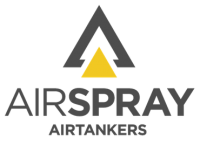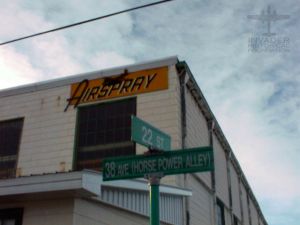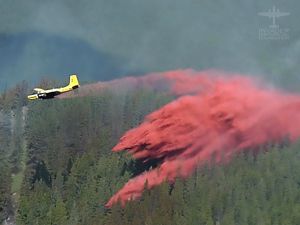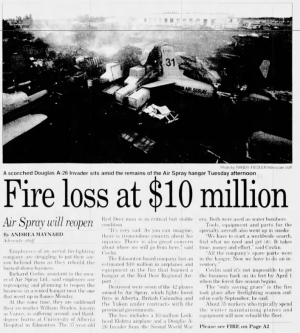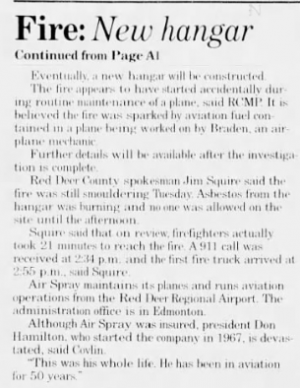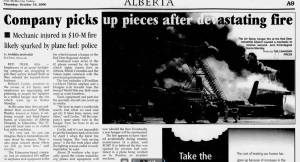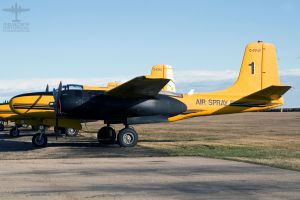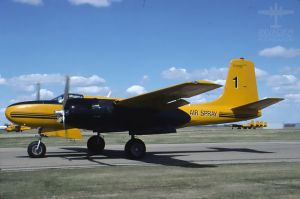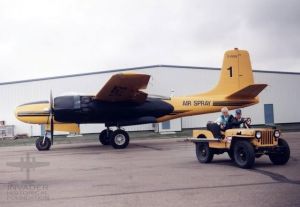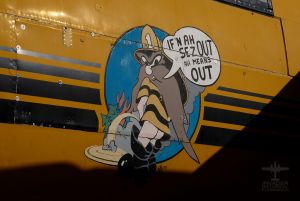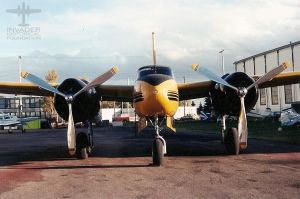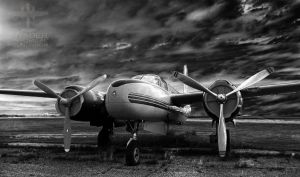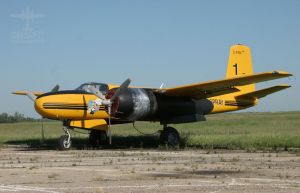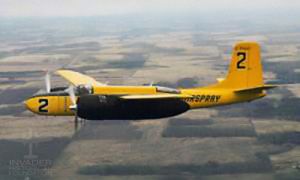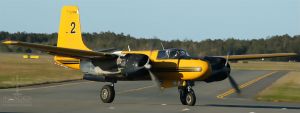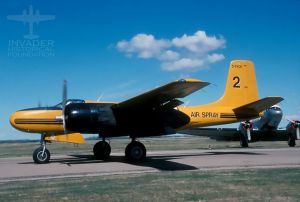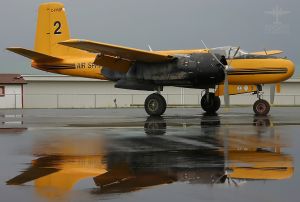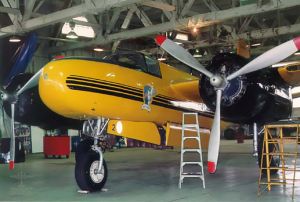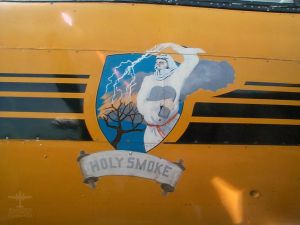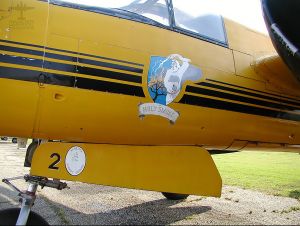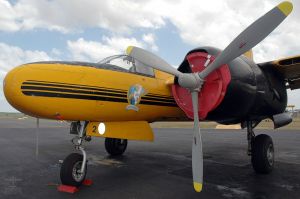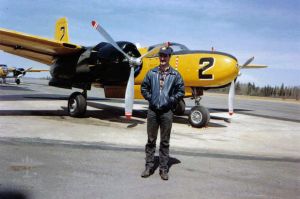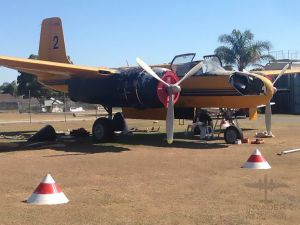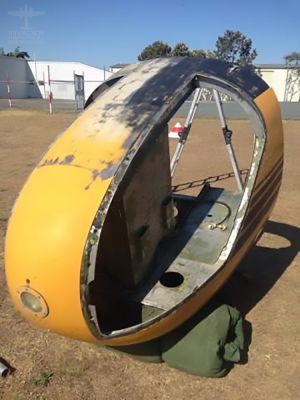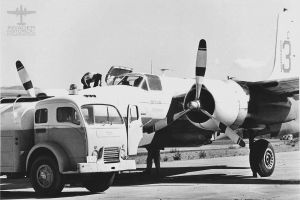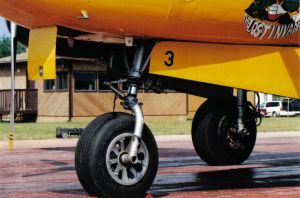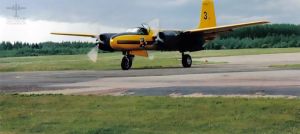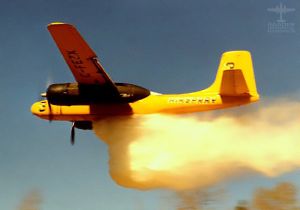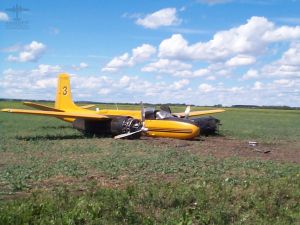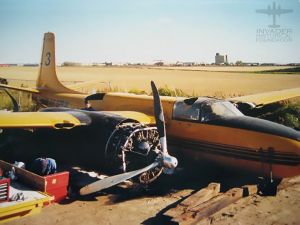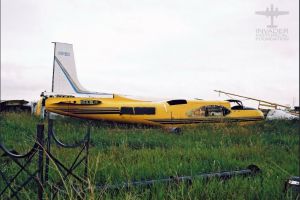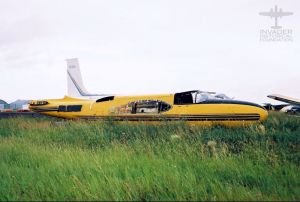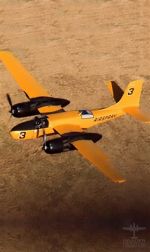Air Spray, Ltd
| Air Spray, Ltd | |||
|---|---|---|---|
| Founded: 1987 | |||
| Headquarters: Edmonton, Alberta | |||
| Bases: Edmonton, Alberta Red Deer, Alberta | |||
| Status: Active | |||
History
Air Spray Ltd. was incorporated in 1954 by Dave Harrington as a crop spraying company in the Wetaskiwin, Alberta area.[1] It later expanded into mosquito control with a contract awarded by the City of Edmonton in 1956. However, in the meantime, the aerial wildfire suppression industry was in its infancy with government agencies seeking a solution to the ever-growing problem of controlling wildfires destroying timber and threatening communities. In response to this need, Air Spray Ltd. was one of a handful of companies in North America that shut down its crop spraying operations and converted its aircraft to fight wildfires.
With the conversion of two Stearman bi-plane aircraft to the air tanker role, Air Spray Ltd. was awarded the first ever aerial wildfire suppression contract issued by the Alberta Government. In June 1960, three Air Spray Stearmans flew to New Brunswick to spray for budworms and later in the season fought a large forest fire in British Columbia for the rest of the season.[2]
In 1961 Air Spray Ltd. switched to the larger and faster TBM Avenger aircraft to provide Alberta with air tanker services. While the TBM Avenger was a relatively effective air tanker, the industry was looking to a next generation alternative in the form of a faster, medium-sized, twin-engine aircraft. The Douglas Invader was identified as the ideal aircraft to become an air tanker. Built in the United States between 1943 and 1945 and used extensively during the Korean war, its powerful twin Rolls Royce engines provided the aircraft with speed and the ability to carry a large payload of fire retardant. It also came equipped with a bomb bay ideal for the installation of a tank to hold the retardant. Several companies throughout North America saw the potential of the A26 and the industry rapidly grew with dozens of Invaderss converted to air tankers during the 1960s and 1970s.
In 1967 Air Spray Ltd. was reincorporated as Air Spray (1967) Ltd. and the company purchased one 1945 Douglas Invader for conversion to an air tanker. After conversion was complete, the company added a Cessna 310 to serve as a birddog aircraft (or lead plane) and Air Spray was awarded a contract for the group by the Province of Alberta. The company was later awarded a contract with the Yukon government for two more Invaders. In 1973 Air Spray's maintenance facilities were relocated from Edmonton, Alberta to the Red Deer Regional Airport at Springbrook, Alberta[3] due to the availability of an aircraft hangar and to allow space for expansion. During the next few years, the company expanded, carrying out several seasonal contracts with various provincial governments. The fleet grew an average of one tanker per year, eventually including 22 Invader air tankers (now retired) and 8 Cessna 310 bird dog aircraft operating under contract.
Air Spray is an Approved Maintenance Organization with Transport Canada[4] and a Repair Station with the Federal Aviation Administration (FAA)[5] and therefore during the summer months, when most firefighting aircraft are on location around the country, the Air Spray staff perform general aircraft maintenance and repairs.[6] In Canada, Air Spray also carries out maintenance, repair and overhaul (MRO) of general aviation customer aircraft under the trade name of Springbrook Aerospace.[4]
Air Spray has focused on expansion outside of Canada. In 2012 Air Spray expanded its operation into the United States with the establishment of Air Spray USA Inc including an air tanker maintenance facility in Chico, California.[7] As well, Air Spray has operated several aircraft in Coahuila[8] Mexico to combat wildfires.
More recently, the company has purchased the BAe 146 passenger jet aircraft for conversion to an air tanker.[9] Air Spray also added Air Tractor AT-802 "Fire Boss" Single Engine Air Tankers (SEATs) to its fleet in 2013.[10]
Air Spray has been involved in fighting many large wildfires including the 2003 Okanagan Mountain Park fire|2003 Okanagan Mountain Park fire, the 2011 Slave Lake, Alberta wildfire and in 2016, the company was involved in fighting the Fort McMurray, Alberta wildfire.[11]
In 2018, Air Spray Ltd. was awarded a contract for aerial firefighting by the Government of Manitoba. The Wildfire Suppression Services Contract was issued by the Manitoba Sustainable Development Agency and is for a period of 10 years. Air Spray is working in partnership with Babcock International to carry out the contract. The contract includes the management, maintenance and operation of Manitoba's fleet of seven Canadair water-bomber amphibious aircraft (four Canadair CL-415s and three CL-215s), supported by three Twin Commander “bird-dog” aircraft. Manitoba retains ownership of the water-bomber aircraft, parts, inventory, special tools and equipment but care and custody is transferred to the contractors.
Firefighting
These images show action shots of AirSpray tankers engaged in fire-fighting activities.
Crew
- Braden, William "Vance" - Mechanic[12]
- Carelton, Kirk - Pilot[13]
- Covlin, Richard "Rick" - Assistant to the owner[12]
- Davidson, Thomas James - Pilot (KIA)[14]
- Duncause, Perry - Pilot[13]
- Garrett, Darcy - Maintenance[15]
- Hamilton, Don - Owner[16]
- Mains, Bob - Maintenance Manager[17][13]
- Muise, Perry - Pilot[13]
- Peel, Gordon "Gord" - Operations Manager/Pilot[15][13]
- Robinson, Berry - Pilot[13]
- Wever, Bert - Pilot[13]
Some photos of the pilots and crew of Airspray.

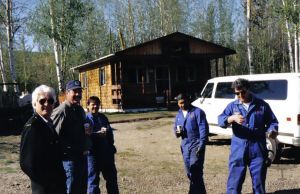

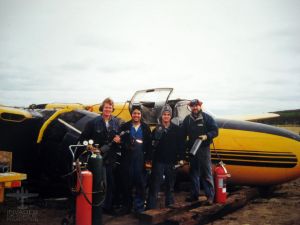
In Memorium
- Unknown - died 24 Apr 1980, Slave Lake, Alberta, Canada
- Davidson, Thomas James - Aged 35 - died 13 Jul 1984, Calgary, Alberta, Canada
Hangar Fire
On Monday, the 16th of October, 2000, the main hangar facility at Red Deer Airport caught fire and burned to the ground. [18]. The loss was tremendous. One worker, 37-year-old William "Vance" Braden of Red Deer, was hospitalized in critical condition with second and third degree burns covering much of his body. [18][12]. Braden was an airplane mechanic employed by Air Spray and is believed to have started the fire accidentally when sparks ignited aviation fuel inside of a plane that he was working on[18][12].
Firefighters received the call about the blaze at 2:34PM but did not arrive on scene until 2:55PM. [18] The fire smoldered well into the next day and the burning asbestos from the hangar posed a health hazard that forced people to stay away from the site until the afternoon of the 17th. [18]
Not including the loss of the building itself, the company lost an estimated $10 Million dollars in aircraft during the conflagration. [18]. Reports vary from 5 to 7 planes lost in the blaze. [18][19][12]. Among the confirmed planes destroyed were a $3 Million Lockheed Electra[18][19], Douglas Invader Tanker #31 (44-35893). [18][19], a Turbo Commander bird dog aircraft[19], a Cessna 310 birddog[19], and a Cessna 120 Birddog[19]. In addition to the hangar and the planes, the company also lost all of the spare parts for the entire fleet, plus the majority of the tools used to maintain the planes[18][19].
The group of 35 mechanics who typically maintain the planes during the winter months were used in repairing and rebuilding the fleet in time for the next fire season in Apr 2001[18][12].
Aircraft
The WW2 era A-26 aircraft were converted to air tankers by fitting the old bomb bay with a 900 US gallon aluminum tank to hold the retardant or slurry, a mixture of clay, water and dye which is released over a fire.[20] The A-26 flew over 30 seasons with Air Spray throughout Alberta, British Columbia, Saskatchewan, Yukon and the Northwest Territories. Flying at a speed of 210 knots, the A-26 was the work horse of Air Spray's air tanker fleet.
In 1986 Air Spray was awarded a contract by the Alberta Government for the operation and maintenance of four Canadair CL-215 air tankers. Air Spray operated and maintained the four aircraft for 17 years. In 1998, Air Spray purchased two Canadair CL-215 aircraft and was the first private owner and operator of this type of aircraft in the world. A third CL215 aircraft expanded the range of operation to include forest fire suppression missions in Yukon, Quebec, Ontario and British Columbia. In early 2009 the Air Spray CL215 aircraft were sold to Turkish Aeronautical Association.
In 1994, Air Spray added to its fleet the Lockheed L-188 Electra, a fast, maneuverable turboprop plane which was converted to carry large loads of fire retardant (3000 US gallons). The more powerful vehicle contributed to a better margin of safety for pilots. Air Spray used the Electra in British Columbia firefighting operations in 1994 and did so for Alberta a year later. The larger turbine aircraft eventually took over the work of the A-26 fleet which was retired at the end of the fire season in 2004.[21] In 2013, Air Spray had the largest fleet of L-188 air tankers in the world.[22]
Air Spray approached the former Aero Union in California to manufacture a tank for the L-188 Electra that would surpass the existing 12 door tank used by the industry on some air tanker aircraft at the time. After certification by Air Spray, the Retardant Aerial Delivery System (RADS) was installed on the L-188 Electra. This improved design consisted of two doors operated by an on-board computer to control the amount of the opening releasing the retardant at any one time, from a long straight line to a full drop of 3,000 US gallons of retardant, better meeting the individual demands of each fire situation. Air Spray is the current owner of the supplemental type certificate (STC) for the RADS tank for the Electra L-188 air tanker.
In addition to its fleet of air tankers, Air Spray has operated a number of "bird dog" aircraft in support of its air tanker activities.[23] The crew aboard the bird dog includes a pilot and one or two air attack officers (AAO), who locate the fire, determine the optimal flight path for the following tanker, and recommend effective retardant dispersal patterns.
Paint Schemes
Air spray used several different paint schemes over the years.
Among the earliest Paint Schemes was this style, dated 1973. The plane was mostly white, with a blue tail and trim.
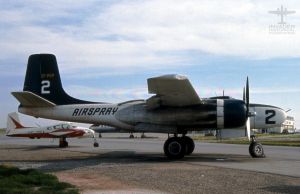
Airspray's next paint scheme was an all-yellow paint scheme with black numbers and the name "Airspray" in big block letters down the side of the aircraft.
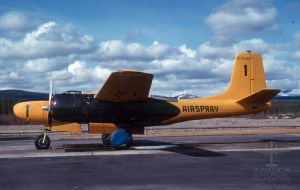
The third and final paint scheme was also all-yellow, but the planes now featured nose-art in addition to the black numbers. Black stripes ran the length of the plane. This photo was taken in May 1995 and shows the third paint scheme in use by that time.

Fleet
| Tail Number | USAF S/N | Canadian Registry | Nose Type | Name | Arrived | Left | Comments |
|---|---|---|---|---|---|---|---|
| 1 | 44-35875 | C-FPGF | Hard Nose | Firefighter | 1970 | 2004 | Was airworthy Sep 2004. Current status is unknown. |
| 2 | 44-35898 | C-FPGP | Hard Nose | Holy Smoke | July 1971 | 2004 | Ex/ N3328G, airworthy Sep 2004. Sold and sent to Randall MacFarlane of Brisbane, Australia. |
| 3 | 43-22660 | C-FEZX | Hard Nose | The Lost Invader | 1989 | 29 Jun 2000 | Written off near Grande Prairie, Alberta 29 Jun 2000 Wreckage stored dismantled at Red Deer. |
| 4 | 44-35444 | C-FTFB | Glass Nose | White Flag Miss Red Deer |
1971 | 2004 | Ex/ N7656C. Was airworthy in Sep 2004. Last notes show sent to Classic Aircraft Museum of Hillsboro, Oregon. |
| 5 | 44-35217 | C-FFIM | Hard Nose | Not Named | 1983 | 13 Jul 1984 | Written off near Calgary, Alberta 13 July 1984 |
| 6 | 44-34724 | C-FBVH | Not Named | 24 Apr 1980 | Written off near Slave Lake, Alberta 24 Apr 1980 | ||
| 8 | 44-34738 | C-GWLU | Hard Nose | Old Yeller | May 1975 | 16 Oct 2000 | Ex/ N600D, damaged beyond repair in hangar fire at Red deer 16 Oct 2000 |
| 9 | 44-35581 | C-GWJG | Hard Nose | Not Named | Jun 1976 | 1 Jul 1982 | Written off near Watson Lake, Yukon 01 Jul 1982 |
| 10 | 44-35708 | C-GXGY | Hard Nose | Not Named | Dec 1976 | 2004 | Ex/ N5530V, was airworthy Sep 2004 Last records show sent to Classic Aircraft Museum of Hillsboro, Oregon. |
| 11 | 44-35661 | C-FCBK | Not Named | 1979 | 12 Aug 2004 | Written off at High Level, Alberta 12 Aug 2004 | |
| 12 | 44-35524 | C-FCUI | Glass Nose | Silver Fox | 22 Jun 1979 | 2004 | Ex/ N9401Z Last notes show it was sent to Reynolds Museum, Wetaskiwin, Alberta. |
| 13 | 44-35857 | C-FZTC | Pogo 2O Lucky Jack |
Aug 1979 | 2004 | Ex/ N9300R Present status is unknown. | |
| 14 | 44-34523 | C-GTOX | Hard Nose | Hasta Luego | Jan 1982 | 2004 | Ex/ N9174Z, was airworthy Sep 2004 Last notes show it was sold 18 Oct 2010 to Robin P. Murray of Strathmore, Australia. |
| 20 | 44-34136 | C-FKBM | Not Named | 2 May 1985 | 2004 | Ex/ N8017E. Still present at Reed Deer Airport as of Feb 2022. | |
| 26 | 43-22653 | C-GPTW | Fire Kat | 1989 | 2004 | Ex/ N9402Z She was sold to the Australian Aviation Museum at Bankstown, Australia in 2010. | |
| 27 | 44-35810 | C-GPUC | Glass Nose | Not Named | 1981 | 16 Oct 2004 | Ex/ N9403Z, destroyed Air Spray hangar fire 16 Oct 2004 |
| 31 | 44-35893 | C-GHCC | No Sweat | 1982 | 16 Oct 2004 | Ex/ N4812E, destroyed Air Spray hangar fire 16 Oct 2004 | |
| 32 | 44-35948 | C-GHLX | Bugs | 15 Jul 1987 | 2004 | Ex/ N161H Now with Champagne Aviation Museum, Urbana, Ohio. It is planned to be restored but is currently not airworthy. | |
| 36 | 44-35456 | C-FAGO | Hard Nose | Dragon Lady | 20 Apr 1983 | 2004 | Ex/ N330WC, was airworthy Sep 2004 Last notes show it was sold to Minter Field Air Museum, Shafter,CA |
| 56 | 44-35497 | C-FOVC | Hard Nose | Safe Passage | 1995 | 2004 | Ex/ N3426G, was airworthy Sep 2004<br?
Current status is unknown. |
| 58 | 44-34121 | C-GHZM | Fire Eaters | 18 Jan 2001 | 2004 | Ex/ N4804E, purchased for spares use. Still present at Red Deer Feb 2022. | |
| 98 | 44-34778 | C-GWLT | Hard Nose | Trail of 98 | May 1975 | 2004 | Ex/ N67943, previously flown as Tanker 7. Last notes show it was sent to Winnipeg, Manitoba and painted as a Canadian warbird, flown in the airshow circuit. |
As of September 2019, Transport Canada lists 43 aircraft registered to Air Spray.[24] As of February 2016, the U.S. Federal Aviation Administration lists six AT802A Air Tractors to Wells Fargo Bank Northwest NA Trustee. (N349AS, N358AS, N376AS, N379AS, N397AS, N398AS)[25]
In addition Transport Canada lists a Douglas A-26 Invader but with a cancelled certificate.[26] There are, at last count, three derelict Invaders parked at the Red Deer Airport that were ex-Air Spray craft that have been dropped from inventory.
Accidents and incidents
- June 30, 2000: An Air Spray Douglas B26C Invader (C-FEZX) air tanker was extensively damaged in a forced landing near the Grande Prairie Airport in Alberta. As the pilot made his approach to runway 25, he advised the air traffic controller that he had lost power in one of his engines. Moments later, he lost power in the second engine. After realizing he wasn't going to make the runway, he initiated a crash landing. The Invader came down in a field near the airport, bounced back into the air again, and then hit the ground and slid about 400 ft before colliding with a road bank which spun the aircraft around and tore off the left engine. The pilot suffered minor injuries. It was later determined that the airplane had run out of fuel.[27]
- August 12, 2004: An Air Spray Douglas B26C Invader (C-FCBK) was on departure from High Level Airport, Alberta, to Rainbow Lake, Alberta, when the pilot rejected the takeoff run at approximately 90 knots due to a power loss on one of the engines. The pilot released the load of fire retardant on the runway, however the aircraft was unable to stop in the remaining distance and came to rest in a drainage ditch approximately 1,200 ft beyond the threshold of the runway, spilling a significant amount of fuel. The aircraft was substantially damaged, however there was no post impact fire. The pilot, who was the sole occupant sustained serious injuries.[28]
Bases
From these bases, AirSpray could provide forest fire-fighting capabilities to anywhere in Alberta. Edmonton was the headquarters, and Red Deer was a major base. The rest of the bases appear to have been smaller bases used on an as-needed basis.
- Dawson City
- Edmonton
- Ft. McMurry
- Ft. Smith
- Loon River
- Pincher Creek
- Red Deer
- Steen River
Red Deer
This was a tanker base that AirSpray used to fight forest fires from. After the Invader fleet was retired in 2004, they were placed into storage at Red Deer.
This satellite photo from Aug 2002 shows Red Deer Airport with 2 "Squadrons" of Air Spray planes present.

This satellite photo from Apr 2005 shows Red Deer airport with all of the remaining Invaders, 14 in total, in open storage after being retired at the end of 2004.
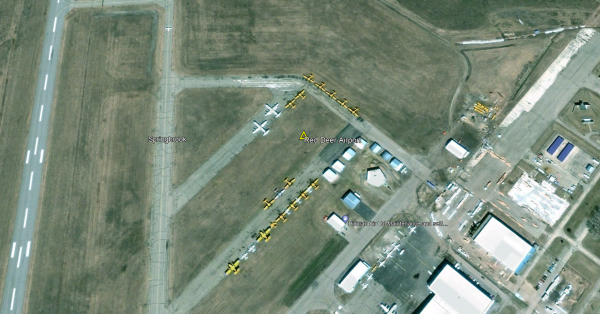
Images
Research Notes
Look into this photo. Tanker #3 was allegedly written off in 1982, but Tanker #3 allegedly didn't join the fleet until 1989, seven years later. So how can they be in the same photo together?
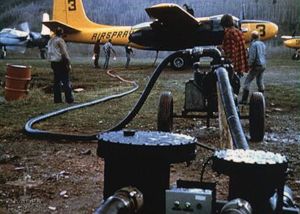
References
- ↑ https://nbstearmans.com/companies-canada/ 2015-04-15
- ↑ https://nbstearmans.com/companies-canada/
- ↑ https://vancouversun.com/news/Lightning+strikes+highway+collision+spark+season+forest+wildfires/9998731/story.html
- ↑ 4.0 4.1 http://wwwapps.tc.gc.ca/Saf-Sec-Sur/2/CAS-SAC/aooar.aspx?id=104-90&lang=eng&typ=1
- ↑ http://av-info.faa.gov/repairstation.asp?certno=7AQR696N
- ↑ http://www.reddeeradvocate.com/business/Air_Spray_Aviation_continues_to_grow_254538831.html
- ↑ https://web.archive.org/web/20121031011647/http://www.chicoer.com/fromthenewspaper/ci_21874357/canadian-company-settling-at-chico-airport-converting-plane ChicoER.com, 28 October 2012.
- ↑ http://www.albertalocalnews.com/business/Air_Spray_flying_to_Mexicos_aid_120958514.html?period=W& "Air Spray flying to Mexico’s aid"
- ↑ http://www.chicoer.com/article/ZZ/20121028/NEWS/121029617
- ↑ http://www.bendbulletin.com/localstate/3338292-151/tiny-tankers-a-big-help-in-prineville.html "
- ↑ CBC New report about the Fort McMurray fire, broadcast May 8, 2016.
- ↑ 12.0 12.1 12.2 12.3 12.4 12.5 Fort MacMurray Today, 19 Oct 2000
- ↑ 13.0 13.1 13.2 13.3 13.4 13.5 13.6 Red Deer Advocate - 12 Sep 1998
- ↑ Calgary Herald - 15 Jul 1984
- ↑ 15.0 15.1 Red Deer Advocate - 17 Apr 1992
- ↑ Ft. MacMurray Times - 19 Oct 2000
- ↑ Red Deer Advocate - 17 May 1998
- ↑ 18.00 18.01 18.02 18.03 18.04 18.05 18.06 18.07 18.08 18.09 18.10 Red Deer Advocate, 18 Oct 2000
- ↑ 19.0 19.1 19.2 19.3 19.4 19.5 19.6 Edmonton Journal - 19 Oct 2000
- ↑ Bell, Gord "History of Aviation in the BC Forest Service" November 2011 published by BC Forest Service
- ↑ https://web.archive.org/web/20130215093821/http://www.wingsmagazine.com/content/view/3584/38/
- ↑ http://www.osoyoostimes.com/airborne-firefighters-are-only-minutes-away-from-assisting-those-in-and-around-osoyoos/
- ↑ https://web.archive.org/web/20160307090902/http://www.springbrookwaskasoo.com/news1104.htm
- ↑ TCregister Air Spray 2019-09-22
- ↑ http://registry.faa.gov/aircraftinquiry/MMS_results.aspx?Mmstxt=0390308&Statetxt=UT&conVal=0&PageNo=1
- ↑ https://wwwapps.tc.gc.ca/Saf-Sec-Sur/2/CCARCS-RIACC/ADet.aspx?id=12014&rfr=RchSimpRes.aspx?cn=%7C%7C&mn=%7C%7C&sn=%7C%7C&on=AIR+SPRAY%7C&m=%7C%7C&print=y Canadian Civil Aircraft Register: Aircraft Details CF-ZTC
- ↑ accident 2000C0585 Air Spray (ASB 3)
- ↑ accident 2004C1528 Air Spray (ASB 11)
